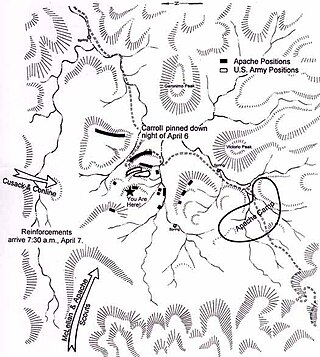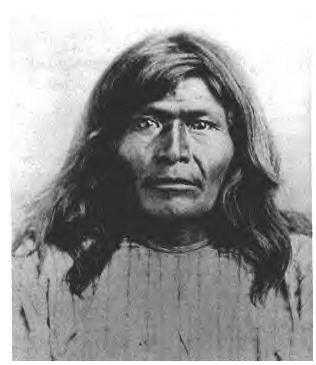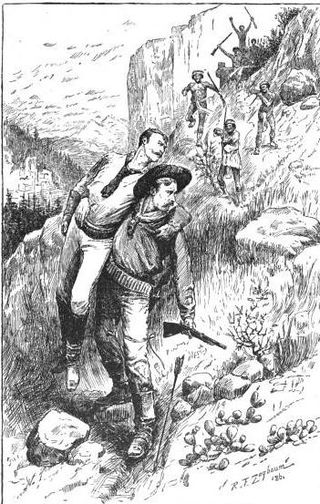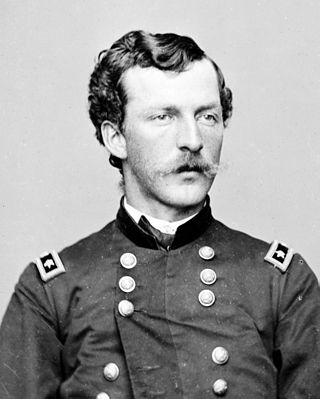
Victorio was a warrior and chief of the Warm Springs band of the Tchihendeh division of the central Apaches in what is now the American states of Texas, New Mexico, Arizona, and the Mexican states of Sonora and Chihuahua.

The Apache Wars were a series of armed conflicts between the United States Army and various Apache tribal confederations fought in the southwest between 1849 and 1886, though minor hostilities continued until as late as 1924. After the Mexican–American War in 1846, the United States annexed conflicted territory from Mexico which was the home of both settlers and Apache tribes. Conflicts continued as American settlers came into traditional Apache lands to raise livestock and crops and to mine minerals.

The 1st Cavalry Regiment is a United States Army regiment that has its antecedents in the early 19th century in the formation of the United States Regiment of Dragoons. To this day, the unit's special designation is "First Regiment of Dragoons". While they were the First Regiment of Dragoons, another unit designated the 1st Cavalry Regiment was formed in 1855 and in 1861 was re-designated the 4th Cavalry Regiment. The First Dragoons became the 1st Cavalry Regiment, since they were the oldest mounted regiment.

The Apache Scouts were part of the United States Army Indian Scouts. Most of their service was during the Apache Wars, between 1849 and 1886, though the last scout retired in 1947. The Apache scouts were the eyes and ears of the United States military and sometimes the cultural translators for the various Apache bands and the Americans. Apache scouts also served in the Navajo War, the Yavapai War, the Mexican Border War and they saw stateside duty during World War II. There has been a great deal written about Apache scouts, both as part of United States Army reports from the field and more colorful accounts written after the events by non-Apaches in newspapers and books. Men such as Al Sieber and Tom Horn were sometimes the commanding officers of small groups of Apache Scouts. As was the custom in the United States military, scouts were generally enlisted with Anglo nicknames or single names. Many Apache Scouts received citations for bravery.

The Battle of Cieneguilla was an engagement of the Jicarilla War involving a group of Jicarilla Apaches, possibly their Ute allies, and the American 1st Cavalry Regiment on March 30, 1854 near what is now Pilar, New Mexico. The Santa Fe Weekly Gazette reported that the action "was one of the severest battles that ever took place between American troops and Red Indians." It was one of the first significant battles between American and Apache forces and was also part of the Ute Wars, in which Ute warriors attempted to resist Westward expansion in the Four Corners region.

The Battle of Big Dry Wash was fought on July 17, 1882, between troops of the United States Army's 3rd Cavalry Regiment and 6th Cavalry Regiment and warriors of the White Mountain Apache tribe.The location of the battle was called "Big Dry Wash" in Major Evans' official report, but later maps called the location "Big Dry Fork", which is how it is cited in the four Medal of Honor citations that resulted from the battle.

The Battle of Mount Gray was an engagement of the Apache Wars fought at the foothills of Gray Mountain on April 7, 1864. A troop of the United States Army's California Column attacked a superior force of Chiricahua Apaches at their camp and routed them from the field.

The Battle of Hembrillo Basin was fought April 5–8, 1880 between the United States Army against a combined band of Chiricahua and Mescalero Apaches led by Chief Victorio. Hembrillo Basin was the largest battle of Victorio's War, although casualties were light on both sides. Victorio held off an attack by superior numbers of army soldiers and Indian scouts, evacuated his women and children from the battlefield, and withdrew successfully. Hembrillo Basin is located on the White Sands Missile Range and access by the public is strictly regulated.
The Battle of Cookes Spring was a skirmish which took place between Apache raiders and the United States Army on March 9, 1857. Apache raiders were tracked through the frontier by a party of U.S. Army cavalry who intercepted the native warriors at Cooke's Spring in the Black Range of New Mexico.

The Bonneville Expedition was a military operation launched by the United States Army in 1857 at the beginning of the Chiricahua Apache Wars. Colonel Benjamin Bonneville, Lieutenant Colonel Dixon S. Miles, and Colonel William W. Loring commanded parties which headed west from Fort Fillmore, New Mexico Territory. The expedition quickly engaged Apaches in two small but significant battles, the first in the Black Range and the second along the Gila River near present-day Safford, Arizona.

The Battle of Devil's River was an 1857 Indian War skirmish which took place in Texas along the Devils River. A small force of United States Army cavalry defeated an overwhelming force of Comanche braves after an epic journey across the desert.

The Battle of Pecos River was fought in 1864 during the Navajo Wars. United States Army troops and Apache Scouts defeated a force of Navajo warriors next to the Pecos River in New Mexico. It is notable for being one of the many Indian war battles involving the California Column.

Victorio's War, or the Victorio Campaign, was an armed conflict between the Apache followers of Chief Victorio, the United States, and Mexico beginning in September 1879. Faced with arrest and forcible relocation from his homeland in New Mexico to San Carlos Indian Reservation in southeastern Arizona, Victorio led a guerrilla war across southern New Mexico, west Texas and northern Mexico. Victorio fought many battles and skirmishes with the United States Army and raided several settlements until the Mexican Army killed him and most of his warriors in October 1880 in the Battle of Tres Castillos. After Victorio's death, his lieutenant Nana led a raid in 1881.

The Battle of Sunset Pass was fought in November 1874 during the Yavapai War. Following the theft of livestock by a band of Tonto Apaches, a troop of United States Army soldiers was dispatched to track the natives and recover the stolen property. The Americans found the raiders at Sunset Pass, in Coconino County, Arizona, where a small skirmish ensued.

The raid on Bear Valley was an armed conflict that occurred in 1886 during Geronimo's War. In late April, a band of Chiricahua Apaches attacked settlements in Santa Cruz County, Arizona over the course of two days. The Apaches raided four cattle ranches in or around Bear Valley, leaving four settlers dead, including a woman and her baby. They also captured a young girl, who was found dead several days after the event, and stole or destroyed a large amount of private property. When the United States Army learned of the attack, an expedition was launched to pursue the hostiles. In May, two small skirmishes were fought just across the international border in Sonora, Mexico but both times the Apaches were able to escape capture.

Pawnee Scouts were employed by the United States Army in the latter half of the 19th century. Like other groups of Indian scouts, Pawnee men were recruited in large numbers to aid in the ongoing conflicts between settlers and the Native Americans in the United States. Because the Pawnee people were at war with the Sioux and Cheyenne and had been under constant pressure and aggression by those tribes, some of them were more than willing to serve with the army for pay. A number of Pawnee served between 1864 and 1871. They were armed with rifles, revolvers and were issued scout uniforms.

The Cherry Creek campaign occurred in March 1890 and was one of the final conflicts between hostile Apaches and the United States Army. It began after a small group of Apaches killed a freight wagon operator, near the San Carlos Reservation, and was part of the larger Apache campaign, beginning in 1889, to round up Apaches who had left the reservations. The American army fought a skirmish with the Apaches near Globe, Arizona, at the mouth of Cherry Creek, which resulted in the deaths of two hostiles and the capture of the remaining three. Two men received the Medal of Honor for their service during the campaign.
The Battle of Devil's Creek was a military engagement during Geronimo's War, fought on May 22, 1885 near Alma, New Mexico. Though it was a minor skirmish, it was the first battle of the Geronimo campaign and ended after the Apaches were routed from their positions.
The Skirmish in Doubtful Canyon took place on May 3, 1864, between a company of infantry from the California Column and a band of about 100 Apaches. The fighting occurred near Steins Peak in Doubtful Canyon, Arizona Territory. Doubtful Canyon, along with Apache Pass and Cookes Canyon, was a favored location for an ambush by the Apache along the Butterfield Overland Mail route.

The Battle of Little Muddy Creek, also known as the Lame Deer Fight, was fought on May 7–8, 1877, by United States soldiers and scouts against a village of Miniconjou Lakota. The battle occurred near Little Muddy Creek in Montana Territory, near present-day Lame Deer, Rosebud County.

















